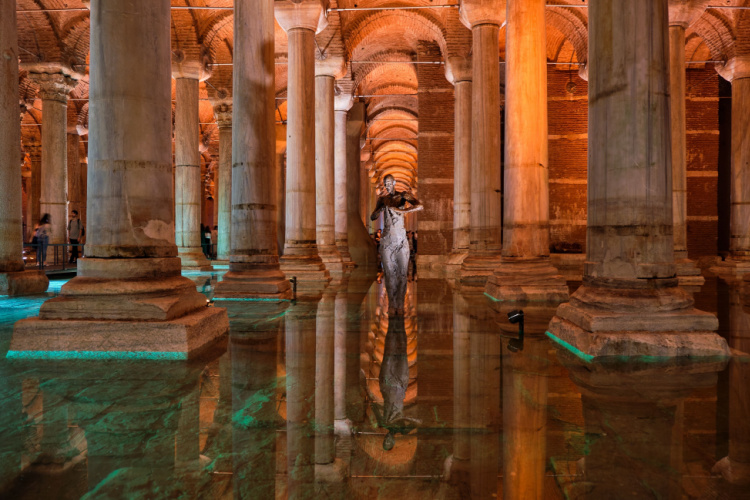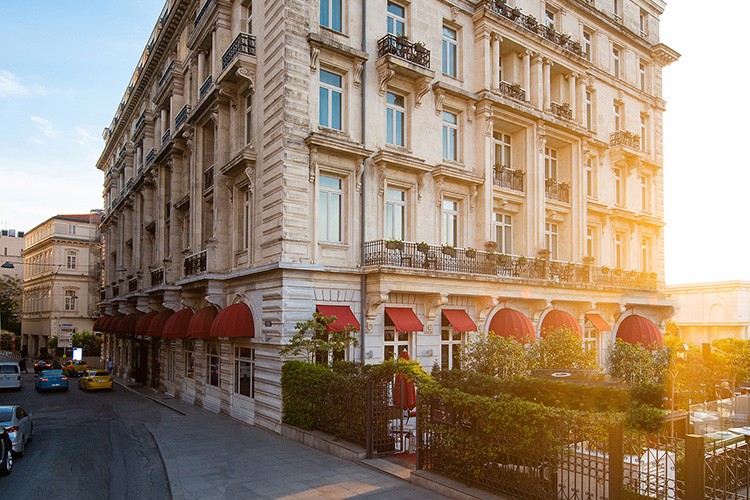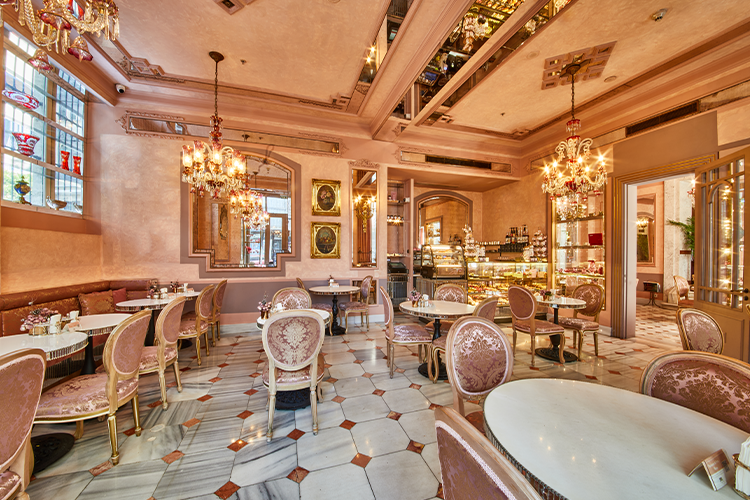6 Cisterns Opening Their Gates to Istanbul’s Mysterious Underworld

Istanbul, which has hosted different civilizations for thousands of years, from the Roman Empire to the Byzantine Empire and the Ottoman Empire, attracts attention with its historical riches. One of these riches is undoubtedly cisterns! The cisterns, carved like mosaics in Istanbul’s historical peninsula, take visitors back to the early days of time capsules. Each of them brings to light the magnificent historical heritage in the depths of the city with its carefully crafted architecture and atmosphere that are full of secrets. Let’s explore the mysterious world of historical cisterns in Istanbul together.
A Mythological Monument Under the Ground: Basilica Cistern
It is possible to say that the most visited cistern in Istanbul is the Basilica Cistern. It is also known as the Basilica Cistern among the public since it was built in 532 on top of the basilica that was destroyed in a fire in 475 AD. The cistern attracts attention with its 336 columns that rise in the water and appear countless due to reflection and the inverted Medusa head, which belongs to the legends.
Basilica Cistern, which has an extremely mystical appearance under dim lights, has a fishpond where coins are thrown to make wishes. Covering an area of approximately 10,000 m², this huge structure brings together historical and mythological elements, allowing you to be in this fascinating atmosphere of Istanbul.
The Second Largest Cistern of Istanbul: Binbirdirek Cistern
The cistern, which was built in the 4th century to meet the water needs of the city during the Byzantine Empire, has a total of 224 columns. It is also called The Cistern of Philoxenos because it met the water needs of the Philoxenos, which has not survived to the present day.
The tops of the columns resemble a truncated pyramid shape, and each has Greek signs. These signs are thought to be traces recorded in history by the workers who contributed to the construction of the building. Today, it mainly hosts events: weddings, dinners, concerts, exhibitions, and fashion shows, adding color to the current existence of this historical cistern.
360 Degree Time Travel: Şerefiye Cistern
Among the mysterious structures that make up the historical texture of Istanbul, the Şerefiye Cistern, built during the reign of Theodosius II, that is, between 428 and 443, welcomes us as a monument that has resisted time. This rectangular planned structure was built to convey Istanbul’s water to the city through The Aqueduct of Valens. 32 columns made of marble brought from Marmara Island to attract attention with their capitals that are decorated with acanthus (Bear’s breeches) leaves.
Younger than Binbirdirek and older than Yerebatan, Şerefiye Cistern is waiting for its visitors on Pierre Loti Street with its stone walls that have the scent of history. Another feature that makes Şerefiye Cistern unique is that it is the oldest building in the world where the 360-degree Projection Mapping system has been implemented, which offers an augmented reality experience.
Revealed During Restoration: Nuruosmaniye Mosque Cellar
In the depths of Nuruosmaniye Mosque, a treasure forgotten by time has resurfaced. As a result of the work carried out in 2013, the 825 square meter cellar, which had been hidden from view for 270 years, was unearthed. The cellar looks like a typical water cistern with its court of porch and columns.
The Nuruosmaniye Cellar contains details that are lost in time and traces of the past. This historical treasure, consisting of nineteen separate sections, was previously used as a temporary exhibition area. Today, under the supervision of the Directorate General of Foundations, it hosts events that contribute to the culture, art, and tourism of Istanbul, especially the Yeditepe Biennial.
Hidden Treasure Under Piri Mehmet Pasha Mosque: Zeyrek Cistern
This work, known as the cistern of the Pantokratoros Monastery, was unearthed thanks to the restoration work that was carried out in recent years. The most important feature that distinguishes Zeyrek Cistern, also known as Unkapanı Cistern, from other structures is that it is located under the Piri Mehmet Pasha Mosque, built in the 16th century. The mosque fascinates its visitors by creating a fascinating contrast with the historical atmosphere of the cistern.
Zeyrek Mosque located right next to the cistern and used after the conversion of the Pantokratoros Monastery, neighbors the cistern with its eye-catching architecture. If you would like to discover the unique view of the historical peninsula and see the silhouette of the city with The Aqueduct of Valens, you should certainly visit the area where the Zeyrek Cistern is located.
The Only Structure Extant from the Hippodrome: The Sphendone of the Hippodrome
The Sphendone of the Hippodrome is located at the southwestern end of the Hippodrome, surrounded by columns. It is known as an area where people from the lower class gather, as it is located at the farthest point from the ostentatious races and the majestic magnificence of the emperor’s throne. This structure, which was damaged by the earthquake that destroyed Istanbul in 557 AD, was turned into a cistern by closing its rooms and corridors in the 9th century. The Sphendone of the Hippodrome must have influenced the travelers of the time because it was described in detail by a Russian traveler who visited the city between 1389 and 91.
Today, there are buildings such as the almshouse of the Sultanahmet Mosque, Marmara University Rectorate Hall and Sultanahmet Vocational and Technical Anatolian High School rising above this historical place. This magnificent work is one of the structures that reveals the rich history of Istanbul as a witness to a story full of traces of time.
From Magnificent Cisterns to Mystical Atmosphere: Pera Palace Hotel

Pera Palace Hotel, which was built in 1888 with the idea of a European-style hotel where Orient Express passengers could stay, has hosted thousands of people until today. Many world-famous artists, statesmen, poets, and writers were among the visitors of the Pera Palace Hotel.
Pera Palace Hotel also has the distinction of being a hotel of firsts in recent Ottoman and Republican history. The hotel took its place in history as the first building where electricity was provided and where electric elevators and running hot water were used for the first time. With its walls carved like embroidery, the sounds of music echoing in the Kubbeli Saloon Tea Lounge and the historical personalities it hosts, Pera Palace Hotel offers you a unique experience full of history and experiences. If you would like to experience an iconic accommodation adjacent to the historical peninsula or take a short break after exploring the mysterious underground world of Istanbul, Pera Palace Hotel might be the place that you are looking for!
These articles may also be of interest to you:
Top 8 Museums You Must Visit in Istanbul
12 Places To Visit In Istanbul For Cultural Tourism Purposes



